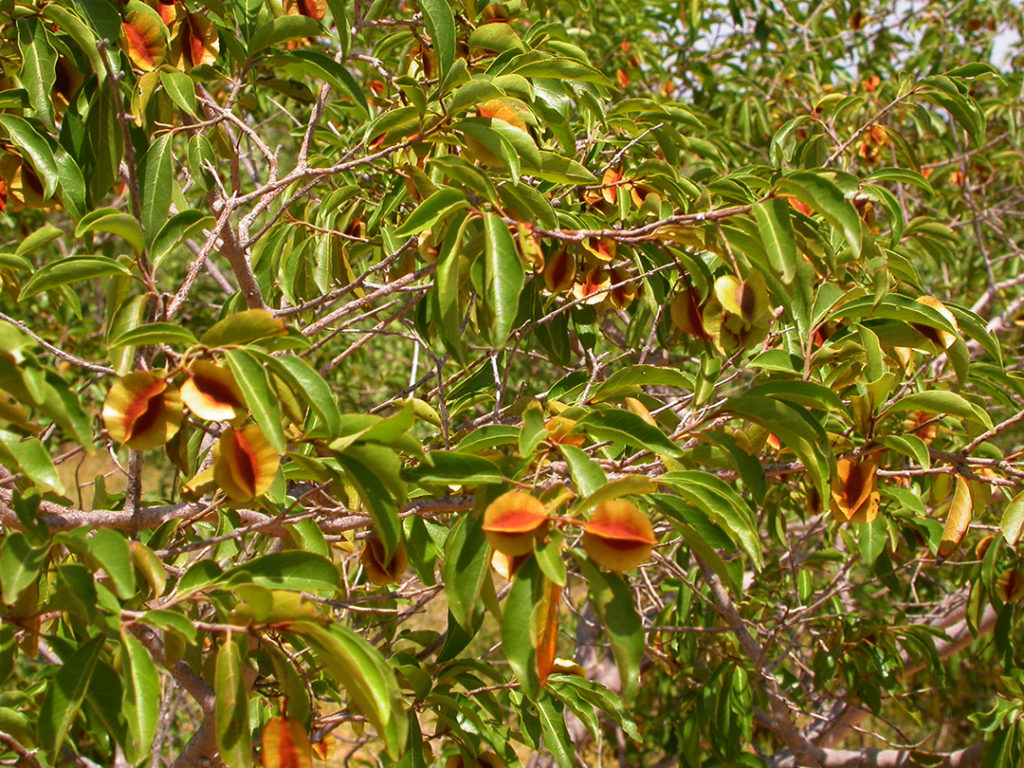
Benin
Combretacea “Kinkeliba”
Combretum micranthum

General Description / Cultural Significance
Kinkeliba, or Combretum micranthum, grows wild everywhere in Benin, year-round. The tree has been used for generations as medicine, and is known by its powerful scent from both its flower and the smell of the tea made from its leaves. Kinkeleba tea is made and drank daily by the Beninese and appreciated for its fortifying and detoxifying properties. The tea is made primarily from its leaves but sometimes the root too, and because the taste is strong, sometimes flavors like lemon are added. It is used as a diuretic and antibiotic against Staphylococcus and E. coli. Leaf extracts have a range of polyphenol compounds that have antiviral and anti-inflammatory properties. Used widely in traditional medicine, studies have shown that liver problems, wounds, fevers, bruises, stiffness, and many other ailments can be treated using parts of the multi-faceted plant.
Climate Change/Conservation Status
According to the IUCN Redlist, Combretum micranthum is not an endangered species. Benin’s forests yield many significant plant varieties, including Kinkeliba, which is why it is absolutely vital to preserve them. Between 2005 and 2015, Benin’s forest cover dropped significantly due to deforestation and poor forest governance, among other issues. Forests provide wood fuel and regulate the breathable air, which are more reasons that they must be preserved.
The majority of Benin’s population lives on its coast, which has already become vulnerable to sea level rise and erosion. Infrastructure and building structures have already been lost to the sea. The impact is also being seen in some sensitive ecosystems. Lagoon waters are increasingly threatened by saltwater intrusion.
The Benin Gazetted Forest Management Project aims to improve the sustainable management of forests so that the threat of species extinction can be controlled. As of 2020 the government has updated its forest policy and code so that conservation actions can be improved.
Alternate Names
Kinkeliba
Dutè
Seh-haw
Sources
Bramante, N., 2015. Kinkeliba Leaves: Benefits and Uses. Artimondo Magazine. [website]
ClimateLinks, 2019. Greenhouse Gas Emissions Factsheet: West Africa Region. U.S. Agency for International Development. [website]
de Morais Lima, G. R., et al., 2012. Bioactivities of the Genus Combretum (Combretaceae): A Review. Molecules (Basel, Switzerland), 17(8), pp. 9142-9206. DOI: 10.3390/molecules17089142
Fyhrquist, P., 2007. Traditional medicinal uses and biological activities of some plant extracts of African Combretum Loefl., Terminalia L. and Pteleopsis Engl. species (Combretaceae). Dissertation, Department of Biological and Environmental Sciences, University of Helsinki. [website]
Okanla, K., 2018. Feeling the heat. Development and Cooperation. [website]
Permanent Mission of the Republic of Benin to the United Nations. This statement can be found on the World Sensorium original website.
Quédraogo, P., et al., 2017. Uses and vulnerability of ligneous species exploited by local environments. Agriculture & Food Security, 6(1). DOI:10.1186/s40066-017-0090-z
Rutgers Office of Research Commercialization, 2009. Anti-Diabetic Agents from Leaves of Combretum micranthum (Kinkeliba). Rutgers University. [website]
UNDP, n.d. UNDP Project Portal: Benin. United Nations Development Programme. [website]
Welch, C.R., et al., 2017. Bioactive polyphenols in kinkéliba tea (Combretum micranthum) and their glucose-lowering activities. Journal of Food and Drug Analysis, 26(2), pp. 487–496. DOI:10.1016/j.jfda.2017.05.009
Welch, C.R., et. al., 2010. Chemistry and pharmacology of Kinkéliba (Combretum micranthum), a west African medicinal plant. Dissertation, Rutgers University. DOI:10.7282/T3TM7B7P

